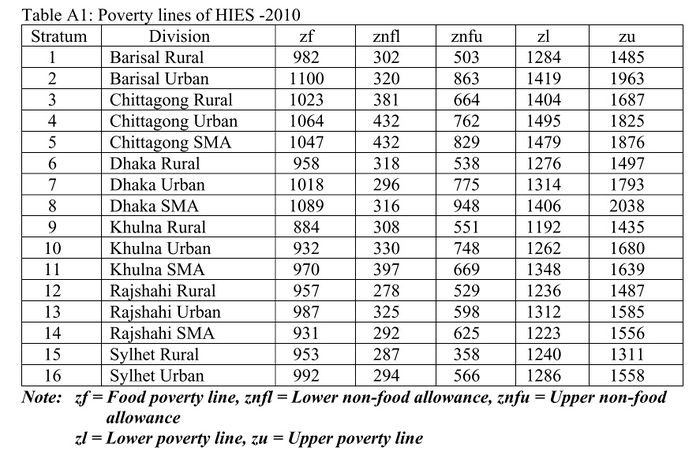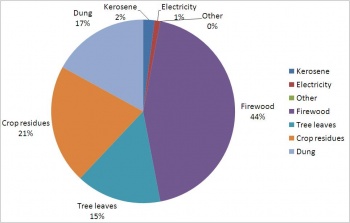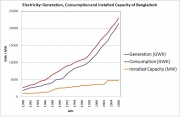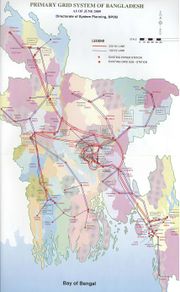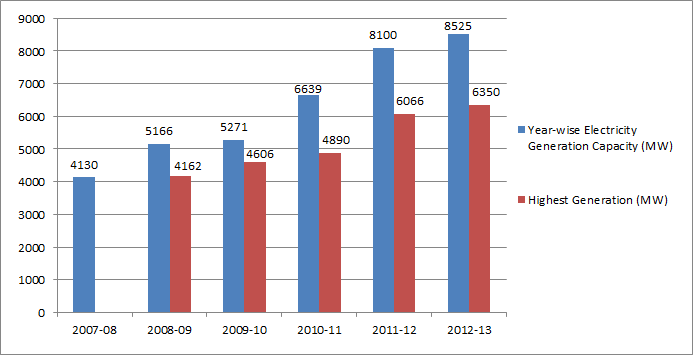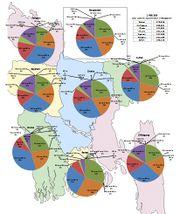Difference between revisions of "Bangladesh Energy Situation"
***** (***** | *****) |
***** (***** | *****) |
||
| Line 642: | Line 642: | ||
<br/> | <br/> | ||
| + | |||
= Market Situation for Different Energy Technologies and Services<br/> = | = Market Situation for Different Energy Technologies and Services<br/> = | ||
| Line 657: | Line 658: | ||
<br/> | <br/> | ||
| − | [[File:Bangladesh SHS Capacitywise installation.jpg|border|center| | + | [[File:Bangladesh SHS Capacitywise installation.jpg|border|center|1000px|Bangladesh SHS Capacitywise installation.jpg|alt=Bangladesh SHS Capacitywise installation.jpg]] |
<br/> | <br/> | ||
| Line 692: | Line 693: | ||
<br/> | <br/> | ||
| + | |||
= Key Problems of the Energy Sector<br/> = | = Key Problems of the Energy Sector<br/> = | ||
Revision as of 09:53, 15 May 2013
Overview
| People's Republic of Bangladesh | |||
| 120px-Flag of Bangladesh.svg.png |
541px-Bangladesh (orthographic projection).svg.png | ||
|
Capital |
Dhaka | ||
|
Official language(s) |
Bangla | ||
|
Government |
Parliamentary Democracy | ||
|
President |
Zillur Rahman | ||
|
Prime Minister |
Sheikh Hasina Wazed | ||
|
Total area |
147,570 km2 | ||
|
Population |
136,700,000 (July 2004 BBS BD)[1] 148,692,000 (2010 revised scenario UNPP)[2] 149,772,364 (March 2011 BBS adjusted pop. census (+4-5% expected))[3] 152,518,015 (March 2013 BBS projected) [4] 161,000,000 (IEA WEO 2011 (calculated from electrification estimates))[5] 161,083,804 (CIA July 2012 est.)[6] | ||
|
GDP (nominal) |
$285.8 billion (2011 estimate)[7] | ||
|
GDP Per capita |
$1700.00 (2011 estimate)[8] | ||
|
Currency |
Taka (BDT) | ||
|
Time zone |
BST (UTC+06) | ||
|
Calling code |
+880 | ||
|
|
Key Statistics
Socio-economic and Demographic Information [9]
Indicators/Variables
|
2011
|
2004
|
1991
|
1. Household size (Dwelling)
|
4.35
|
4.66
|
5.5
|
2. Sanitary toilet facilities (%)
|
61.6
|
N/A
|
N/A
|
3.Sex ratio
|
99.68
|
104.1
|
106.26
|
4. Literacy (%)
|
47.68
|
38.06
|
24.90
|
5a. Economic activity rate (Male) (%)
|
66
|
68.1
|
77.1
|
5b. Economic activity rate (Female) (%)
|
9.8
|
5.4
|
6.7
|
6. Gross growth rate
|
1.08
|
1.26
|
1.66
|
7. Internal migration (rural to urban) (%)
|
4.29
|
4.79
|
5.62
|
8. International migration rate (%)
|
3.46
|
N/A
|
N/A
|
Poverty Situation
Energy Situation
Bangladesh is one of the world's poorest and most densely populated nations. Data from the last Household Income and Expenditure Survey 2005 revealed that 40% of the country’s population was classified as poor, with incomes below the upper national poverty line. In rural areas this rate is even higher, counting 44% of the population as poor (urban areas 28%). One fourth of the population is considered extremely poor (urban: 15%; rural: 29%), having incomes below the lower poverty line. Access to modern energy services is one of the reasons for poverty and low economic development.
Today only an estimated 49% of the Bangladesh population is connected to the electricity grid. The electricity supply is not reliable though and peak demand cannot be met. In the rural areas, where more than 70% of the population lives, only about 25% have electricity.
Only about 6% of the entire population has access to natural gas, primarily in urban areas. Biomass fuels, such as wood, cow dung and agricultural residues are collected mainly from the local environment and have become a traded commodity as cooking fuel as access to local biomass becomes ever more difficult. Inefficient, kerosene based lamps are the most common sources of light. The kerosene price has increased from 42 tk (end 2010) to 61 tk (end 2012)[10]. Further price hikes are expected to come in place during 2012. The supply of new gas connections to industries have been suspended in 2009 and resumed in April 2012 [11]. At the same time new gas connections to household, which were restricted and therefore expensive, have now been suspended "for the time being" [12].
Energy Supply
About 70% of the population of Bangladesh live in rural areas. The rural economy is characterized by slow growth, high unemployment, insufficient infrastructure and widespread poverty. Due to the lack of electricity supply in rural areas, the rural population depends mainly on biomass as a source of energy. Over 70% of total primary energy consumption is covered by biomass, mainly agricultural waste and wood.
Source of Lights (in %)
| Source | 2011 | 2004 | 1991 |
| Grid Electricity | 53[13]; 56.6 [14] |
39.77 | 14.37 |
| Solar Energy | - | - | |
| Kerosene |
39.5[14] | 59.93 | 84.73 |
| Biogas | 0.1[14] | - | - |
| Others | 0.5[14] | 0.31 | 0.89 |
According to the 2010 household income and expenditure survey only 55% were electrified (See access rate). According to the above data however it is 59.9%.
It is also not clear how these figures come together as 100% separation is unlikely. Eg. an electrified household will still use Kerosene during powercuts for lighting or have a solar backup....
Not assessed: grid independent non renewable energy like diesel generators...
Source of Cooking Fuels (in %) [9]
| Fuel Type | 2011 | 2004 | 1991 |
| Wood | 34.8 | 31.76 | 44.27 |
| Kerosene | 1.0 | 1.79 | 0.57 |
| Gas/LPG | 12.6 | 9.09 | 2.36 |
| Electricity | 0.4 | 0.76 | 0.88 |
| Straw/Leaf/Dried cow dung | 51.2 | 55.91 | - |
| Bio-gas | 0.1 | - | - |
See also: Fuel Prices
Energy Consumption
Energy Demand in the Household Sector
Most Bangladeshi households in rural areas (99%) as well as urban areas (66%) use biomass such as wood, cow dung, jute sticks or other agricultural wastes for cooking. Inefficient and poorly ventilated clay stoves produce fine particles, polycyclic aromatic hydrocarbons, carbon monoxide, dioxins and other carcinogens (ROUSE 2004). Housewives are exposed to high levels of these toxins between three and seven hours a day. Research revealed that this indoor air pollution (IAP) occurs not only in the kitchen but only slightly lower in the living area therewith affecting also other family members such as children. The World Health Organisation (WHO) estimated (based on 2002 data) that more than 46,000 women and children die each year as a direct result of exposure to indoor air pollution, while many more suffer from respiratory diseases, tuberculosis, asthma, cardiovascular disease, eye diseases, and lung cancer. Further WHO attributes 1.3 million disability adjusted life years (DALY) to the use of solid fuels . Right behind unsafe water and inadequate sanitation, indoor air pollution is the second biggest environmental contributor to illness worldwide (WHO 2007[15]).
Although the estimated per capita consumption of timber and fuel wood is one of the lowest in the world, biomass is becoming increasingly scarce and costly. The natural growth of forests as well as afforestation measures are too low to meet the consumption of the population due to inefficient burning of biomass for cooking purposes and high population growths, putting pressure on the economic situation of biomass-purchasing households. Poor rural households have to spend a significant amount of time on biomass collection. Wastage of biomass is depriving the soil of nutrients, resulting in unsustainable low levels of organic matter in the soil.
The figure shows the distribution of the energy consumption of rural households. Nearly one half of the total consumption is for firewood.
Annual Household Energy Consumption: All Divisions (average per household)[16]
| Energy Type | All Uses | Cooking | Parboiling | Other | Cooling | Lighting | Amusement |
| Biomass (kg) | |||||||
| Fuelwood | 1,186.21 | 1,064.84 | 28.60 | 92.77 | — | — | — |
| Tree leaves | 501.51 | 470.67 | 29.99 | 0.85 | — | — | — |
| Crop residue | 708.18 | 538.86 | 164.41 | 2.72 | — | — | — |
| Dung cake/stick | 523.90 | 503.68 | 16.07 | 4.16 | — | — | — |
| Sawdust | 8.40 | 8.36 | 0.02 | 0.02 | — | — | — |
| Non-biomass | |||||||
| Candle (piece) | 15.86 | — | — | — | — | 15.86 | — |
| Kerosene (liter) | 28.98 | 1.76 | — | 0.07 | — | 27.16 | — |
| Natural gas (Tk) | 9.59 | 9.59 | — | — | — | — | — |
| LPG/LNG (liter) | 0.05 | 0.05 | — | — | — | — | — |
| Grid electricity (kWh) | 143.83 | 0.25 | — | 4.00 | 49.50 | 80.74 | 9.34 |
| Solar PV (kWh) | 0.53 | — | — | — | 0.04 | 0.48 | 0.01 |
| Storage cell (kWh) | 0.55 | — | — | — | — | 0.14 | 0.41 |
| Dry-cell battery (piece) | 15.01 | — | — | — | — | — | — |
Electricity
The government’s vision of electrifying the entire country by 2020 through grid expansion may not be realistic due to inaccessibility and low consumer density in many rural areas, as well as financial constraints. To reach the government’s vision of universal electrification, renewable energy sources, in particular solar energy will have to play a vital role for off-grid electrification.
Within the reach of the national grid Bangladesh is still reeling under 600 - 1200 MW of ‘load-shedding’. A situation which deteriorates during irrigation seasons, when the demand-supply gap reaches up to 1500 MW. Domestic and industrial sectors consume about 43% and 44% electrical energy respectively, i.e. a total of about 87% of power consumption occurs in these two sectors. Out of this, a large part of electrical energy is consumed for lighting. All power sector experts acknowledge that the maximum power gap occurs primarily during the evening. A way to manage the evening load is the introduction of energy efficient lights/lighting systems.
[17] Electricity Situation: At a Glance (31st December 2012) [Source: The Daily Prothom Alo, dated 06 March 2013]
| Generation Capacity | 8525 MW |
| Maximum Generation (on 04 August 2012) | 6350 MW |
| Transmission Line | 8949 Km |
| Distribution Line | 281,123 Km |
| Distribution Loss | 12% |
| Per Capita Electricity Generation (inuding captive generation) | 292 kW-hr |
| Number of Cloents (connection wise) | 13.64 million |
| Total Beneficiries | 95.60 million |
| % of Population Getting Electricity (incl. renewable sources) | 60% |
Electricity Generation
Different types of power plants generate electricity and synchronize it with the national grid. There are some isolated diesel power stations at remote places and islands which are not connected with the National Grid. Terminal voltage of different generators are 11 kV, 11.5 kV and 15.75 kV.
In the Eastern Zone (eastern side of river Jamuna), electricity is generated from indigenous gas and a small percentage through hydro power.
In the Western Zone, Coal and imported liquid fuel is used for generation of electricity. The fuel cost per unit generation in the Western Zone is much higher than that of the Eastern Zone. Therefore, as a policy, low cost electricity generated in the Eastern Zone is transferred to the Western Zone through the 230 kV East-West Inter connector transmission line.
Prime Minister Sheikh Hasina (4.11.09) said the government has taken plans to set up solar power plants to generate 280 MW by 2013. She told the parliament that the country, which has now short of about 1,200 to 1,700 MW power, would get rid of the power crisis by 2011 as 1,487 MW of power will be generated and added to the national grid by then.
The installed capacity in Bangladesh as increased by roughly 2,000MW between 2009-2011 and is now about 6,900MW (August 2011). Peak hour demand is about 6,000 MW everyday and increases on hot summer days. Maximum demand served so far is 6350 MW on August 4, 2012 (accessed on September 9, 2012).[18]
Bangladesh´s electricity supply strongly relies on gas: About 67.21% of the power plants are fired by gas. Furnace oil, diesel, coal and hydro power are responsible for 21.70%, 6.15%, 2.41 % and 2.65% of the total electricity supply respectively (accessed on September 9, 2012).[19] A list of all power plants is provided by BPDB here (16kB). The acute gas shortage causes a loss in production of around 600MW.
Bangladesh has signed a protocol deal with Russia on October 21, 2011 after series talks on cooperation in the field of peaceful usage of nuclear energy as the country plans to install a nuclear power plant in Pabna district, some 216 km northwest of capital Dhaka.
Access Rate
Bangladesh is one of the world’s lowest energy producers. Electricity, critical to economic growth, has reached only about half of households, despite the country’s successful rural electrification program. With the exception of kerosene, commercial fuels are beyond reach for many. Bangladesh’s reliance on biomass for cooking will continue for several decades; Today only around 49% of the Bangladesh population is connected to the electricity grid and in the rural areas, where more than 70% of the population lives, only 25% have electricity. A mere 6% of the entire population has access to natural gas, primarily in urban areas. Biomass fuels, collected mainly from the local environment only two decades ago, are fast becoming a marketed commodity as access to local biomass becomes ever more difficult. The stark reality is that many rural residents are dependent on such fuels as agricultural residues, dung, and even leaves and grass for cooking.
Energy Access based on presence of expenditures for electricity (HIES 2010)
|
|
Total |
Rural |
Urban |
|
National |
55.26% |
42.49% |
90.1% |
|
Barisal: |
40.12% |
31.62% |
82.33% |
|
Chittagong: |
60.34% |
48.84% |
92.31% |
|
Dhaka: |
67.34% |
47.36% |
96.15% |
|
Khulna: |
54.13% |
45.55% |
83.83% |
|
Rajshahi: |
51.88% |
46.94% |
75.53% |
|
Rangpur: |
30.07% |
24.44% |
68.68% |
|
Sylhet: |
47.22% |
39.09% |
88.94% |
Market Situation for Different Energy Technologies and Services
Solar Energy
Solar photovoltaic: Solar photovoltaic (PV) systems are in use throughout the country with over 1.88 million household-level installations having capacity of about 80 MW (December 2012). Scaling-up of solar PV systems assisted by the development partners are being implemented through Infrastructure Development Company Limited (IDCOL), Rural Electrification Board (REB), Local Government Engineering Department (LGED), Bangladesh Power Development Board (BPDB), NGOs and Private Organizations implementing solar energy program. There is a strong potential for solar energy within the country. Dissemination of solar home systems (SHSs) is being promoted mainly by IDCOL,private sector companies and NGOs based on the direct-sale approach and provision of refinancing funds for micro-financing of SHSs to participating organizations (mostly NGOs) through IDCOL.
Solar Thermal Power / Concentrating Solar Power (CSP)': The technology involves harnessing solar radiation for generation of electricity through a number of steps finally generating mechanical energy to run a generator. This technology needs to be disseminated in the country to supplement the power supply.
Wind Energy
Wind Energy has also made some inroads but its potential is mainly in coastal areas, and offshore islands with strong wind regimes. These coastal settings afford good opportunities for wind-powered pumping and electricity generation. Presently there are 2 MW of installed wind turbines at Feni and Kutubdia.
Biomass
Bangladesh has strong potential for biomass gasification based electricity. More common biomass resources available in the country are rice husk, crop residue, wood, jute stick, animal waste, municipal waste, sugarcane bagasse etc. This technology can be disseminated on a larger scale for electricity generation.
Biogas
Biogas mainly from animal and municipal wastes may be one of the promising renewable energy resources for Bangladesh. Presently there are tens of thousands of households and village-level biogas plants in place throughout the country. It is a potential source to harness basic biogas technology for cooking, and rural and peri-urban electrification to provide electricity during periods of power shortfalls.
Hydro Power
Microhydro and minihydro have limited potential in Bangladesh, with the exception of Chittagong and the Chittagong Hill tracts. Hydropower assessments have identified some possible sites from 10 kW to 5 MW but no appreciable capacity has yet been installed. There is one hydro power plant at Kaptai established in the 1960s with present installed capacity of 230 MW.
Other Renewable Sources
Other renewable energy sources include bio-fuels, gasohol, geothermal, river current, wave and tidal energy. Potentialities of these sources are yet to be explored.
Key Problems of the Energy Sector
- Only 49% of its 160 million people are connected to the electricity grid and, in the rural areas, where more than 70% of the population lives, only 25% have electricity
- A mere 6% of the entire population has access to natural gas, primarily in urban areas
- Electricity supply is not reliable and peak demand cannot be met
- Substantial amount of energy is used inefficiently
- Most people in the rural areas depend on kerosene lamps for light
- 90% of all Bangladeshis cook with biomass, such as rice straw, dried leaves, jute sticks, cow dung, or wood.
Policy Framework, Laws and Regulations
Poverty Reduction Strategy
All mentioned problems related to inefficient biomass and indoor air pollution use are addressed in the Bangladesh Poverty Reduction Strategy Paper (PRSP)[20], chapters 5.H.1 ‘Conservation of Nature’ and 5.H.2 ‘Combating Pollution’:
- "The relationship between the amount of the fire wood use and level of income is clearly positive and monotonic. This means that the poor has much less access to quality fuel for cooking. Income poverty thus translates into energy poverty." (p. 164)
- "Population pressure on land has been leading to conversion of forest land and land under tree cover into other uses. This at the same time further lowers the supply of biomass and fuel wood for cooking raising their market value including further deforestation and cutting down of trees. Smoke due to fuel wood burning also is a major cause of a significant rise in the level of indoor air pollution affecting adversely the health of women and children." (p.164)
- "Air pollution needs to address both the outdoor and indoor sources of pollution. […] Indoor air pollution is mainly caused by cooking fuels such as firewood and dried cow dung. Most of the poor families use these as fuel and women and children are the main victims of indoor air pollution. Due to air pollution the number of people suffering from respiratory diseases is on the rise." (p. 167)
The PRSP derives the following national strategies to address the mentioned problems:
- "For controlling indoor air pollution use of natural gas, biogas and LPG may be encouraged through various means including policy supports for their lower relative prices as well as more efficient and cost- effective cooking stoves." (p. 167)
- The introduction of energy efficient cook stoves was set one of the key targets to control air pollution in rural settings. "Building coalitions with NGOs for wider dissemination of fuel-efficient cooking stoves" and "Promote R&D to change building and construction standards and designs for pollution-free kitchens" were the respective planned actions on the policy agenda for the fiscal year 2005/06 (p. 301).
General Energy Policy, Energy Strategy
The Bangladeshi Energy Strategy of 1996 with its actualisation in 2002 is the main document of the promotion of RE It focusses on energy supply in rural areas. In December 2009 the "Renewable Energy Policy for Bangladesh was ratified. It was intended to integrate this policy paper into the New Energy Policy (NEP). The NEP was developed in 2006 by the "Renewable Energy and Energy Efficiency Programme" in cooperation with the UNDP.
The Renewable Energy Policy (Download PDF; 83 kB)[21] contains the following parts:
- Overview of potentials of RE sources
- Institutional arrangements in the RE sector (above all the responsibilities of the Sustainable Renewable Energy Authority (SREDA) which has been approved on Monday 18th of July 2012[22]
- Resource, technology and program development
- Investment and fiscal incentives
- Regulatory Policy
Specific Strategies (Biomass, renewable energies, rural electrification, energy access strategy etc.)
Important Laws and Regulations
The Private Sector Power Generation Policy (Download PDF; 135kB)[23] shall attract private investment for installing new power generation capacity on build-own-operate (BOO) basis.
Number of Fiscal Incentives are provided in the Policy for the private power companies. Some of them are as follows:
- Exemption from corporate income tax for a period of 15 years.
- Exemption from Customs Duties (CD), VAT (Value Added Tax) and any other surcharges in importing plants and equipment.
- Repatriation of equity along with dividends allowed freely.
- Exemption from income tax for foreign lenders to such companies.
- Avoidance of double taxation case of foreign investors on the basis of bilateral agreements.
- Remittance of up to 50% of salary of the foreigners employed in Bangladesh.
- Companies are eligible for all other concessions which are available to industrial projects.
The Renewable Energy Policy (see above) provides incentives for renewable energy. Some of them are as follows:
- all renewable energy equipments and related raw materials in producing renewable energy equipments will be exempted from charging 15% VAT.
- a network of micro-credit support system will be established especially in rural and remote areas to provide financial support for purchases of renewable energy equipment.
- SEDA will consider providing subsidies to utilities for installation of solar, wind, biomass or any other renewable/clean energy projects.
- Renewable energy project investors both in public and private sectors shall be exempted from corporate income tax for a period of 5 years from the date of notification of this policy in the official gazette and it will be extended periodically following impact assessment of tax exemption on renewable energy.
- An incentive tariff may be considered for electricity generated from renewable energy sources which may be 10% higher than the highest purchase price of electricity by the utility from private generators.
Furthermore a lot of procedures will be simplified and investment in renewable energy and energy efficiency projects will be facilitated.
Short explanation to what degree EnDev activities are consistent with the national poverty reduction and energy policy
Institutional Set-up in the Energy Sector, Activities of Other Donors
Please confine your explanation to areas relevant for the intended project activities
Governmental institutions
- Bangladesh Energy Regulatory Commission (BERC): BERC has authority over consumer protection, approval of tariffs and pricing, issuance of generation and distribution licenses, and promotion of competition.
- Power Cell: Within the MPEMR power division, the Power Cell oversees power sector reform.
- Rural Electrification Board (REB): REB oversees operations of consumer-owned rural electric cooperatives (PBSs). It performs supervisory and regulatory duties to ensure that technical standards are met and performance is monitored.
- Sustainable and Renewable Energy Development Agency (SREDA): SREDA will act as a focal point for sustainable energy development and promotion, ‘sustainable energy’ comprising renewable energy and energy efficiency. (This institution is not established yet but concrete steps have been taken in this regard by the Government, with SED support).
- Bangladesh Power Development Board (BPDB): BPDB operates most publicly owned generators and some urban distributors; it acts as a single buyer, purchasing from public and private generators and selling to distributors.
- Power Grid Company of Bangladesh (PGCB): PGCB is a wholly owned subsidiary of the BPDB, operates the national transmission grid, schedules grid operations and wheels energy to distributors.
- The Dhaka Power Distribution Company Ltd. (DPDCL): DPDCL distributes energy and conducts commercial operations in Dhaka and adjoining areas, except for Mirpur and Gulshan.
- Dhaka Electricity Supply Company Ltd. (DESCO): DESCO distributes energy and conducts commercial operations in the Mirpur and Gulshan jurisdictions of the Dhaka metropolitan area.
- West Zone Power Distribution Company (WZPDC): The WZPDC is responsible for regional distribution in Khulna.
Private Sector (enterprises, NGOs)
- Summit Power Company: A private power company that operates some smaller size power plants.
- EnergyPac: A private sector enterprise that produces transormers, energy saving lamps, etc.
- Rahim Afrooz: The biggest manufacturer of batteries in Bangladesh. Besides battery manufacturing, it is also involved in the import of solar panels and installation of solar home systems:
- Infrastructure Development CompanyLimited (IDCOL): IDCOL is a government owned company. Although its mandate is to finance all types of infrastructure projects in Bangladesh, its main activity is to manage REREDP project and biogas projects supported by KfW and SNV.
- Grameen Shakti (GS): The biggest NGO involved in the dissemination of renewable energy technologies in Bangladesh.
- Rural Services Foundation (RSF): A foundation established by Rahim Afrooz. It is engaged in the dissemination of renewable energy technologies.
- Bangladesh Rehabilitation Assistance Committee (BRAC): One of the biggest NGOs in the world and internationally active. The focal areas are wide, in Bangladesh they comprise of poverty allevation, micro-finance, health, environmental protection, and social empowerment, also through provision of improved energy services with a focus on solar household systems.
Activities of Other Donors
- Asian Development Bank (ADB): The ADB as the major donor took the coordinating role and acts as the chief negotiator with the Government of Bangladesh. All international donor activities in the energy sector are coordinated by the Local Consultative Group led by ADB. Since recently ADB is providing funds to the REREDP program implemented by IDCOL.
- The World Bank (WB): The WB is providing funds to the Government of Bangladesh to increase the electricity generation, transmission and distribution capacity. The WB initiated the REREDP program and is still financing the credit part of the program.
- Japan International Cooperation Agency (JICA): JICA is helping Bangladesh in the generation of electricity. Currently, JICA is also providing funds to REREDP program.
- Global Environment Facility (GEF): GEF has supported REREDP from the very beginning and plans to undertake projects in the areas energy efficiency and improved brick kilns.
- SNV: SNV is active in the field of biogas technology dissemination and is showing interest in improved cook stoves.
- Urban Partnership for Poverty Reduction (UPPR): Under UNDP initiated UPPR is collaborating with SED in the cook stove sector and is also open for cooperation in biogas plants in urban settings.
- U.S. Agency for International Development (USAID): USAID has been supporting rural electrification program of Bangladesh for the last 35 years. Currently, USAID supported the implementation of the project “Integrated Protected Area Comanagement” (IPAC). SED and IPAC are collaborating in the promotion of improved cook stoves.
- Practical Action (PA): PA is mostly active in infrastructure and livelihood improvement in poor urban areas. As part of their efforts to provide energy access to the poor, they are interested to cooperate with SED in the promotion of improved cook stove as well as related monitoring and evaluation activities.
- Swedish International Development Agency (SIDA): SIDA is planning to start improved cook stove activities in Bangladesh. It is not yet decided wheter this will happen in cooperation with GIZ.
- UK Department for International Development (DFID): DFID has made tremendous funds available for electrification projects. They have indicated strong interest in SHS/SSHS, PicoPV as well as improved cook stove activities. Also they will be active in the field of political advisory, e.g. they are working on the topic of reallocation of subsidies for energy services and fuels.
- Climate and Clean Air Coalition (CCAC): CCAC is a new partnership represented by the USA, Canada, Sweden, Mexico, Ghana and Bangladesh. This group is focussing on the reduction of short lived pollutants such as black carbon and methane by promoting new environmentally friendly technologies and processes like improved cook stoves, brick kilns and rice parboiling system. Detailed discussions for cooperation have taken place in Toronto and Paris recently.
- Kreditanstalt für Wiederaufbau (KfW): Besides their efforts in rehabilitation of old power plants and grid efficiency, KfW has been a strong promoter and supporter of the SHS and SSHS dissemination under IDCOL. Further cooperation can be envisaged also for PicoPV.
- Global Alliance for Clean Cookstove (GACC): GACC, an UN Foundation, is now start working in Bangladesh and developing a Country Action Paln (CAP) which will give the whole cookstove sector participants a common platform.
Further Information
- Restoring Balance: Bangladesh's Rural Energy Realities (ESMAP Report)
- Energy Access, Efficiency, and Poverty - How many Households are Energy Poor in Bangladesh? (World Bank Policy Research Working Paper)
- LGED-REIN.orgBAngladeshs renewable energy information network
- Alamgir-Kabir (Bangladesh Power Development Board, Sept. 2011) presentation on Energy Sector and Solar Projects
- vcbcb
- Rural Electrification and Renewable Energy Development (World Bank Report)
References
- ↑ http://www.bbs.gov.bd/Home.aspx Bangladesh Bureau of Statistics
- ↑ http://esa.un.org/unpd/wpp/unpp/p2k0data.asp
- ↑ http://www.bbs.gov.bd/WebTestApplication/userfiles/Image/Census2011/Bangladesh_glance.pdf
- ↑ http://www.bbs.gov.bd/Home.aspx
- ↑ http://www.iea.org/weo/electricity.asp
- ↑ https://www.cia.gov/library/publications/the-world-factbook/geos/bg.html
- ↑ https://www.cia.gov/library/publications/the-world-factbook/geos/bg.html
- ↑ https://www.cia.gov/library/publications/the-world-factbook/geos/bg.html
- ↑ 9.0 9.1 http://www.bbs.gov.bd/WebTestApplication/userfiles/Image/BBS/Socio_Economic.pdf
- ↑ http://www.thedailystar.net/newDesign/news-details.php?nid=216321
- ↑ http://www.globserver.com/en/bangladesh/press/bangladesh-resume-new-gas-connections-industrial-users-2012-03-03-1
- ↑ http://www.thedailystar.net/newDesign/news-details.php?nid=239013
- ↑ 13.0 13.1 Bangladesh Power Division
- ↑ 14.0 14.1 14.2 14.3 14.4 Bangladesh Population and Housing Census 2011
- ↑ http://www.who.int/indoorair/publications/indoor_air_national_burden_estimate_revised.pdf WHO
- ↑ BIDS Survey 2004
- ↑ http://www.eprothomalo.com/index.php?opt=view&page=1&date=2013-03-06
- ↑ http://www.bpdb.gov.bd/bpdb/index.php?option=com_content&view=article&id=5&Itemid=6
- ↑ http://www.bpdb.gov.bd/bpdb/index.php?option=com_content&view=article&id=5&Itemid=6
- ↑ Bangladesh Poverty Reduction Strategy Paper
- ↑ http://www.powercell.gov.bd/images/additional_images/REP_English.pdf
- ↑ http://www.thefinancialexpress-bd.com/more.php?news_id=133542&date=2012-06-19
- ↑ http://www.powercell.gov.bd/images/additional_images/PSEPGPB.pdf

